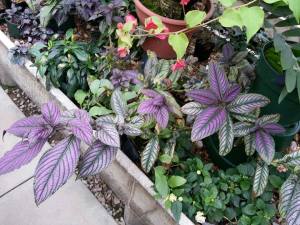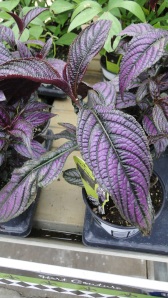With iridescent, glowing purple leaves, Persian Shields are colorful tropical perennials. They perform best in mineral rich, moist soils in partial sun or shade. The foliage is actually dark green, despite its radiating colors.
Strobilanthes dyerianus (Persian Shield, Burmada Conehead) [synonym Strobilanthes dyeriana]
Deciduous: no
Hardiness Zones: 10-11
Height: 30-90 centimeters (12-36 inches) tall
Diameter: 30-90 centimeters (12-36 inches) spread
Growth Rate: moderate
Age: perennial
Root System: Phosphorus supplements improve root growth.
Family: Acanthaceae
Subspecies: none
Tolerates: moist soils, herbivores (deer)
Problems (major): none
Problems (minor): Consistently wet soils choke root systems and may lead to rot or Rhizoctonia (a type of harmful fungus). Spider mites may also inhibit growth.
Poisonous: Contact may cause dermatitis; do not ingest.
Soil requirements: prefers rich (high-nutrient), consistently moist, sandy/light or loamy/medium, well-drained soils with a slightly acidic pH between 5.5-6.5
Air requirements: prefers high humidity
Watering requirement: moderate
Sun requirement: full sun to part-shade (potentially full shade in very warm climates)
Leaf shape: ovate to lanceolate, dark green with a shining/iridescent light to dark purple colors
Leaf size:up to 20 centimeters (8 inches) long by 8 centimeters (3 inches) wide
Stem structure: soft-stemmed, turning somewhat arborescent (semi-woody) with age
Flower structure: tiny, purple or blue, cone-like inflorescences
Flowering frequency: seasonal
Monocot/Dicot: dicot
Notable characteristics:
These are easily propagated by cuttings.
Uses:
These are grown solely for ornamental purposes.
Sources used:
- http://www.missouribotanicalgarden.org/PlantFinder/PlantFinderDetails.aspx?kempercode=a122
- http://gardeningsolutions.ifas.ufl.edu/giam/plants_and_grasses/houseplants_foliage/persian_shield.html
- http://plants.ces.ncsu.edu/plants/all/strobilanthes-dyerianus/
- http://www.backyardgardener.com/plantname/pda_f08d.html
- http://davesgarden.com/guides/pf/go/516/#b
- http://plants.usda.gov/core/profile?symbol=STROB
- http://www.shootgardening.co.uk/plant/strobilanthes-dyeriana

Trailing form at Southern Illinois Univeristy Carbondale PLB greenhouse
All of the images provided were taken by me. They may be used for educational/informational purposes only, provided that this article/online journal is appropriately cited first.


